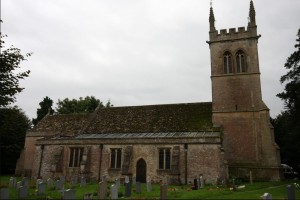 St. Laurence Church in Hilmarton, a charming little 12th century Norman parish church, has had a large old Bible on a shelf behind the pews since the mid-19th century. A note next to it claimed that it was from the second of two original printings of the King James Bible done in 1611, but nobody really expected it to be true.
St. Laurence Church in Hilmarton, a charming little 12th century Norman parish church, has had a large old Bible on a shelf behind the pews since the mid-19th century. A note next to it claimed that it was from the second of two original printings of the King James Bible done in 1611, but nobody really expected it to be true.
Since this year marks the 400th anniversary of the original King James printing, the parish council finally decided to research their Bible. They took it to an expert, the Rev. David Smith at the Museum of the Book in London, and he immediately recognized it as one of approximately 200 remaining original King James Bibles.
Smith identified it thanks to a printing error – a place in the Gospel of Matthew that should say Jesus entered the Garden of Gethsemane and spoke to his disciples instead says that Judas, who betrayed Jesus to the Romans, entered the garden.
That the St. Laurence Bible had that error, but not another one in the Book of Ruth, enabled Smith to pinpoint exactly when the book had been printed, Procter explained.
The first printed edition had a misprint in Ruth 3:15 reading “he went into the city,” instead of the proper “she went into the city.” Because of this misprint, the first and second 1611 editions are known as the “He” and “She” Bibles. That makes the St. Laurence one a “She” Bible.
When the King James version was first printed, 100 years before it was even called the King James Bible, it was called simply the Authorized Version and it was published in large folios for distribution to Church of England pulpits. These were never intended for private home perusal.
Since the St. Laurence parish church had been up and running for 500 or so years by then, it’s eminently possible that this is the Authorized Version they received in 1611. All we know about its direct history is that it was re-discovered the first time in 1857 by St. Laurence vicar the Reverend Francis Fisher. He recognized its historical importance and cleaned it up.
Unfortunately, he also mutilated it by trimming the pages so they would fit his hand-carved oak cover. Because of the trimming and the missing first four chapters of Genesis, this almost complete Bible is officially considered a fragment.
The parish will be getting a glass case to display the Bible in a more secure environment.